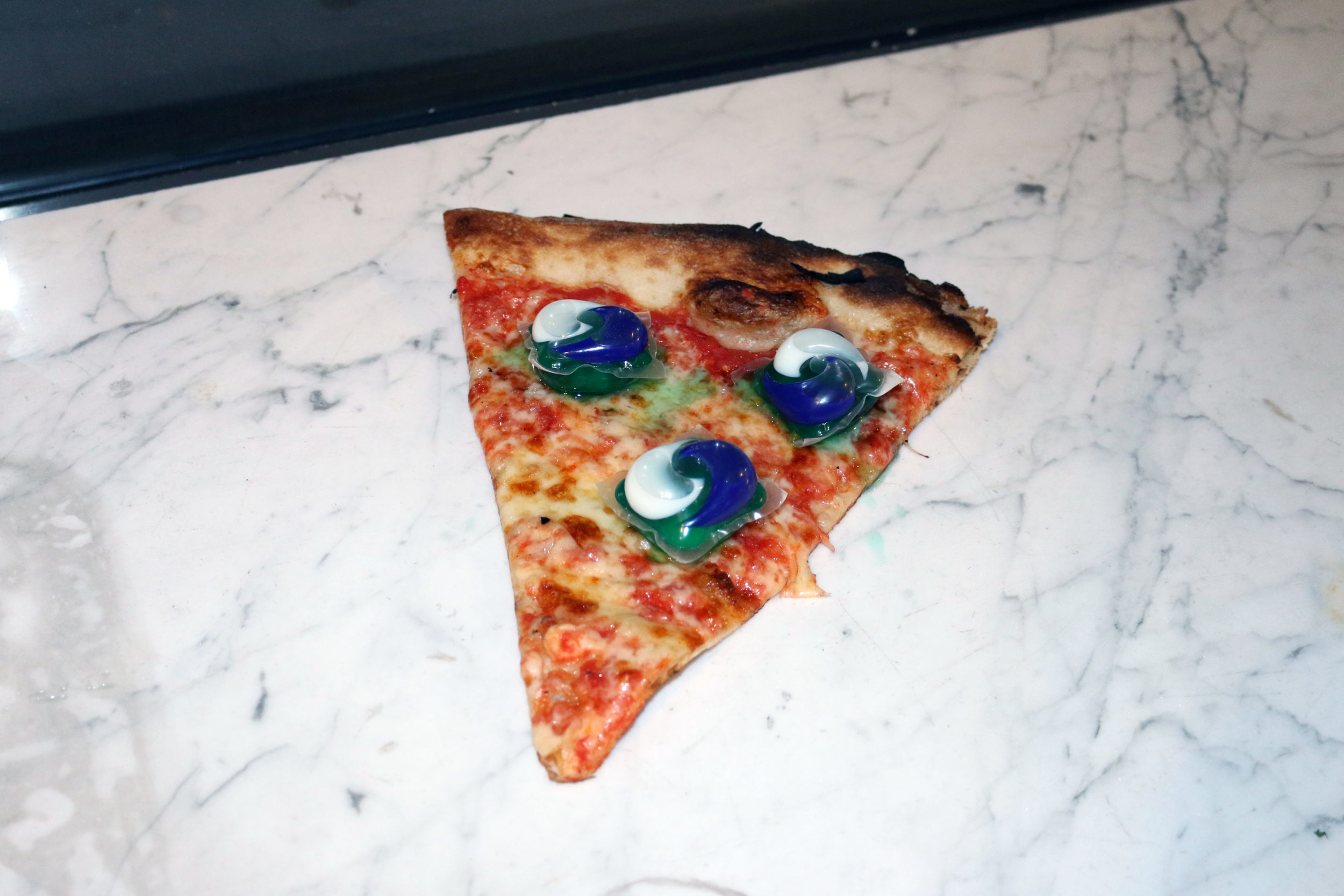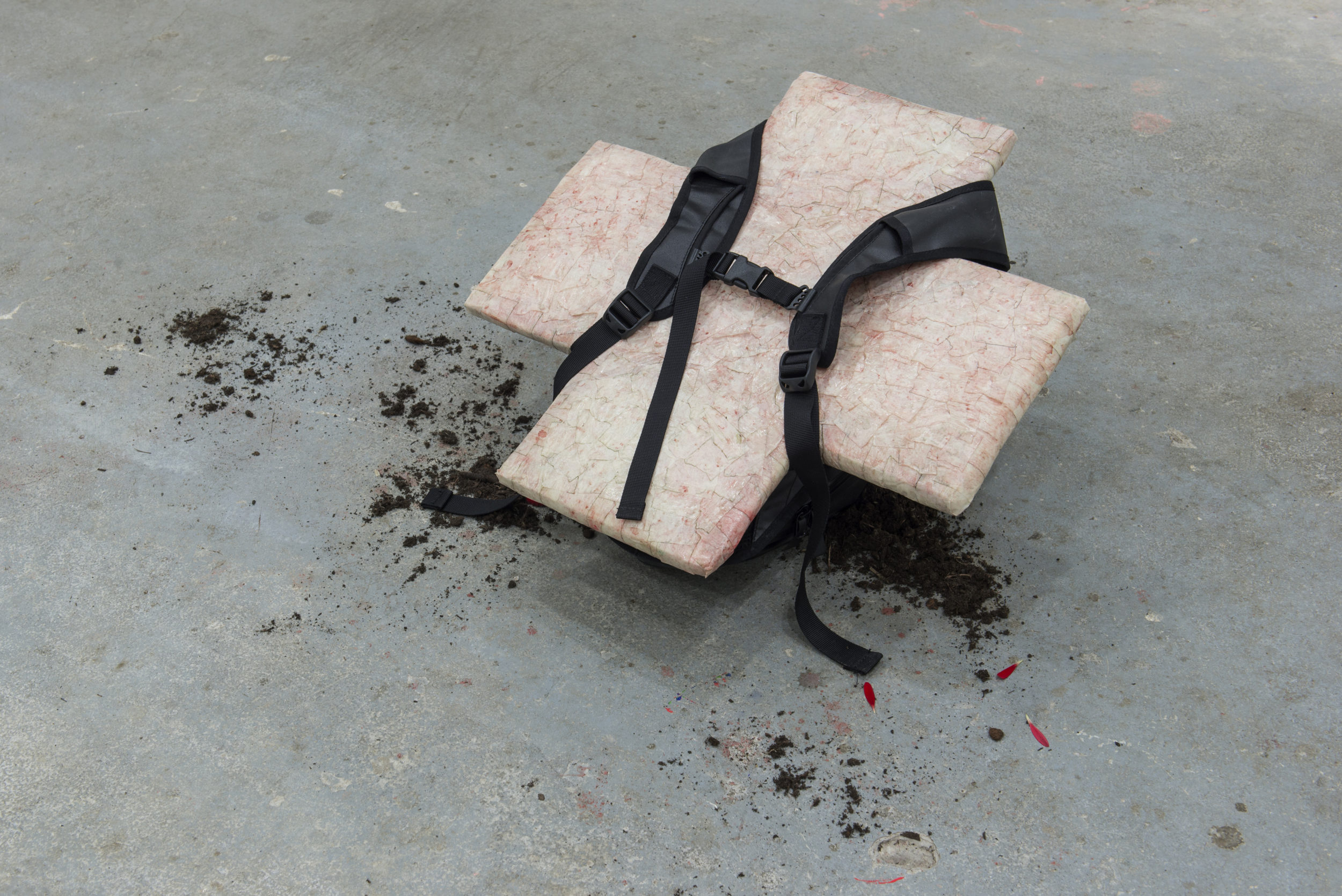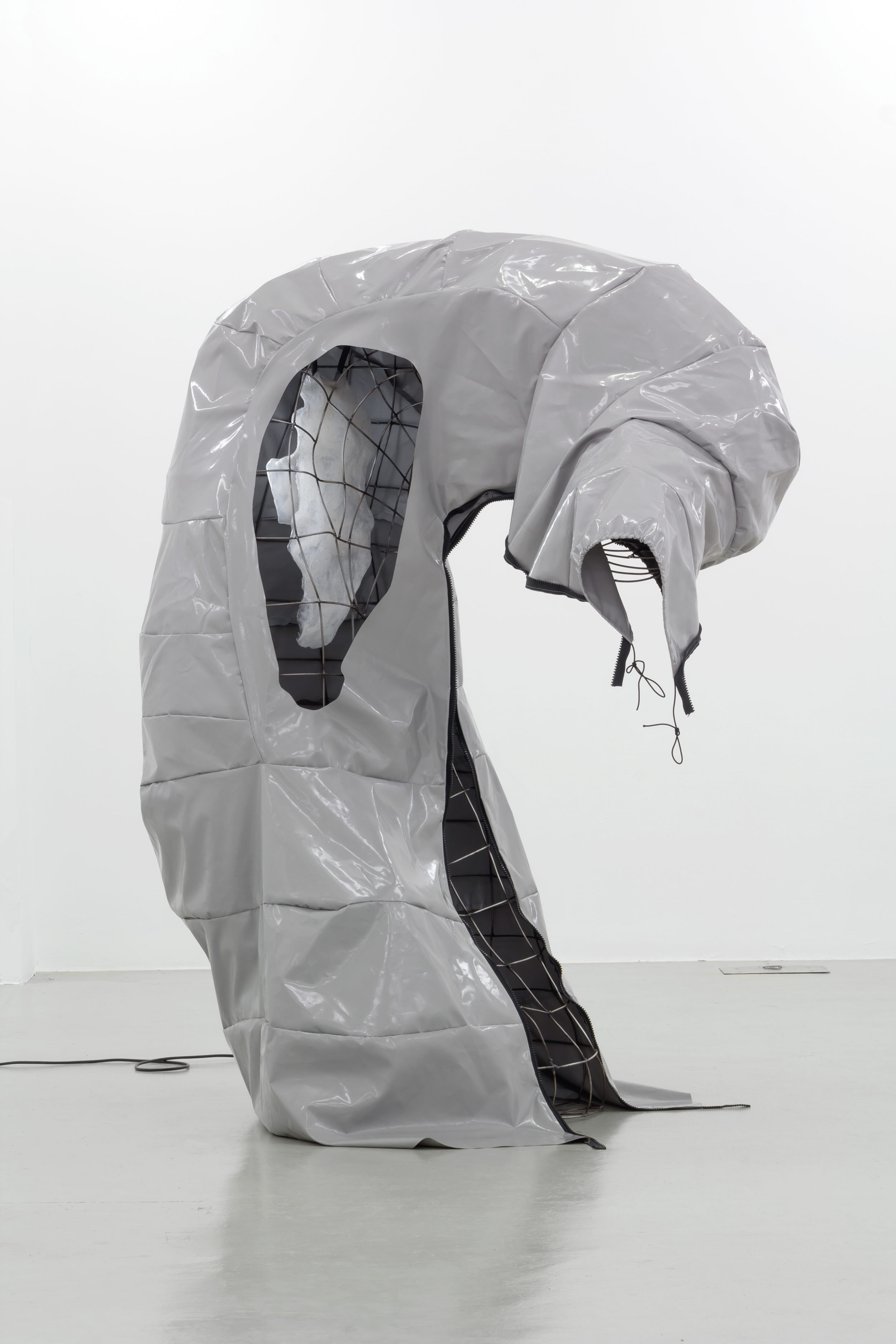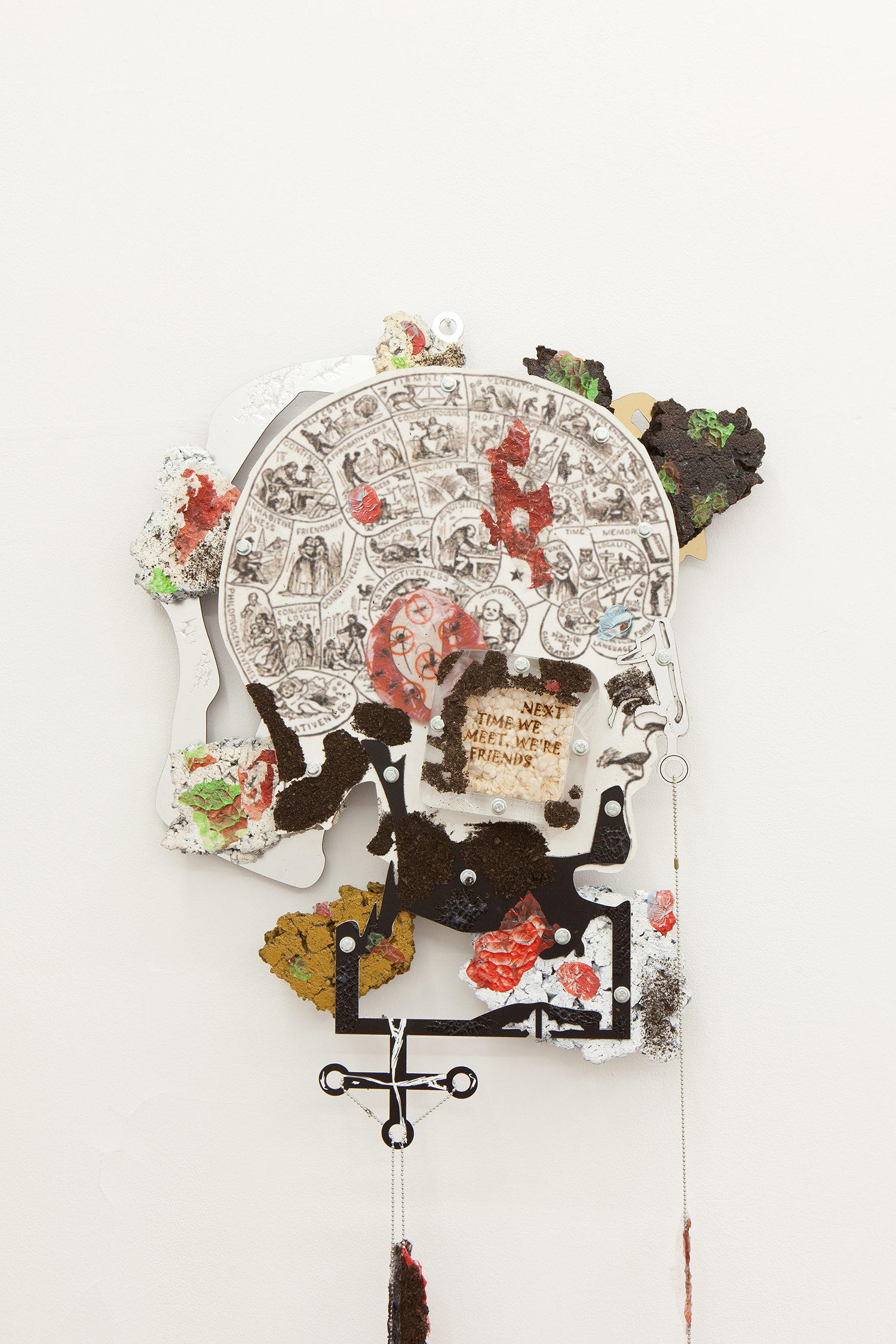World War Me
Natalya Serkova

When we look at contemporary art objects in real life or on the screen, we often do not understand what they are made of and how. And this is not a question of complex technological process or the use of the previously unprecedented media. When reading the description of an object, we might exclaim at times: ‘Ah, that’s what it is’ or ‘Wow, that simple, I would have never thought!’ We find in these annotations materials that are quite familiar to us: wood, rubber, silicone, the most common types of paint, banal organic ingredients, some supermarket products, etc. At the end of their transformation, the object produced from these ingredients exceeds the sum total of its constituent parts. These materials (stapled, welded, mixed or twisted together) generate something that makes us squint, wrinkle our nose and move closer for a better look in an attempt to figure out what it is exactly that we behold right in front of us. In the last few years, the trend towards the production of art objects that can be formally characterized by the ‘what is this?’ question has gained momentum. Is there any reasonable explanation for this?
When I say ‘reasonable’ I can not help but admit a certain assumption that I am making here. At the juncture of modernity we are currently at, it is hardly possible at all to determine any criteria of what constitutes “reasonable”. For instance, is it reasonable to bite into a laundry detergent pod? And yet, not so long ago tens of thousands of people intentionally ingested laundry pods while recording their experiences on camera. The Tide Pod Challenge flashmob exponentially occurred for no apparent reason and just as quickly came to naught, remaining an incomprehensible precedent. In order to stop mass poisonings and burns of the mucous membrane, the areas most affected by the flashmob started to produce pod-shaped donuts covered with glaze resembling the shape and color of the laundry pods filled with the colorful chemical goo.
And yet, was not a dangerous scientific experiment that was meant to expand our knowledge of the world once elevated as the beacon of rational science of the Enlightenment era? When one is dramatically short of the usual means of exploring reality, they can only resort to the universally accessible option, the time-honored, tried-and-true practice of feeling the texture, shape and taste of an object and exploring its contents by simply putting it into their mouth and biting into it. When we do that, we activate the mucous membrane of the tongue, the most sensitive outer tissue of the human body capable of instantly introducing the substances that have entered it into the blood circulatory system. The act of biting into a capsule literally fuses us with its contents: it is hard to think of a better way to achieve a closer, fuller contact with an object. Yet at the same time, in order for the idea of this kind of experiment and the desire to conduct it to enter somebody’s consciousness there should be some properties that would make the capsule stand out of the wide range of material objects surrounding the observer that leave them undisturbed and indifferent to the idea of exploring their insides. The capsule has to become a disquieting and frightening object containing a secret inside so that the restless observer is prompted to crack it, regardless of the consequence, in order to regain their composure. One can argue that the rational scientific experiments of the Enlightenment era were not conducted in order for the scientist to regain their composure, but rather, at the expense of losing it. But is the expectation of a peaceful ruling over the tamed nature that far removed from the expectation of immersing oneself into the extra-natural Sea of Tranquility?
Apparently, the capsule brings together the properties the symbiosis of which cannot leave us indifferent—we have not yet learned to be indifferent to it. On the one hand, we can behold the glossy, streamlined, twisting and flirting transparent forms of the capsule shell through which the colored liquid shines. On the other hand, we are aware that this liquid possesses a specific ability to remove stains and dirt from clothing and textiles, in other words, to make things clean, to return them to the state they once were in and that they have lost through contact with various surfaces, tissues, substances and the like. The most obvious explanation of the appetite for the capsule is its similarity to a smoothness and sleekness toffee candy in color. Still, this external resemblance would hardly suffice to explain the mass desire to conduct a dangerous experiment.

Saliva or water dissolve the shell, releasing the liquid, thereby triggering the cleansing process. The release of the cleansing agent is an important technology that has allowed humans throughout history to conquer the territories of control. From the heat treatment of soil in order to control soil-borne pests for better plant propagation to the total cleansing of spaces through the release of atomic energy, humans have always played the dangerous game of overmastering the cleaning agent. Besides the specific and often terrifying practical task, such cleansing has always had a somewhat calming effect on whoever used this technology, as it transformed the space of the heterogeneous, the untamed (because of the too large a number of the unknown variables it contained) into the space of the uniquely possible. Not unlike the heat treatment of soil that uses fire to destroy the harmful bacteria, pests and the seeds of the weed plants and to render the soil sterile and fertile, any other purification similarly contains within itself the logic of obliterating, erasing the internal differences within the whole. By the same logic, cleansing prevents us from perceiving the difference within the confines of the cleaned fabric: the stain, once removed, no longer draws our attention to the part of the garment previously soiled and allows the textile to regain its initial state of homogeneity.
The capsule with the liquid detergent contains indiscernibility within itself. However, this indiscernibility, this “uniquely possible”, this promise of the undividable holistic entity cannot fail to contain an echo of a particular worldview, which by its very logic contains the supernatural and the mystical. The desired unification with the capsule becomes the manifestation of the desperate attempt of modern humans to no longer domesticate the purifying force, capable of clarifying something around them, but rather to merge with what it carries within. The gift of the capsule becomes a paradoxical combination of the indiscernible and the discernible, the hidden and the overt, the unattainably holistic and therefore the closest, the uniquely possible that simultaneously opens up a space for a maneuver. And if such a paradox could previously be mostly attributed to the religious and mystical mode of cognition, in today’s world it has penetrated the field of rigorous scientific experimentation. The observer-experimenter is now completely immersed in the studied space, deprived of a safe vantage point for their observation that could previously allow them to observe the life and death of living beings and phenomena separated from the observer by a transparent partition screen. [1] Today’s partition screen is melting on the tongue, burning the mucous membranes of anyone who acknowledge their complete inclusion in the painful processes. The state of being fully included renders the following paradox quite plausible: the expansion of possibilities accompanied by a nervous tetanus caused by a painful shock.
(…) by exploring the material world by touch we can hope to enter into a sufficiently intimate contact with the world of objects, and only a permanent anticipation of a dangerous situation on the road can force us
to be constantly alert, watchful and fully engaged creatively and
intellectually.
“We live in < …> a world in which objects are suffused with and surrounded by mysterious hermeneutical clouds of unknowing’, says Timothy Morton [2], and these clouds become for us the promise of the most incredible, frightening and strange discoveries inside the things that we are used to being familiar to. Such hermeneutical clouds are particularly condensed around specific objects of the most recent contemporary art, going beyond the horizon of our perception and submerging the object into the haze of permanent inadequate clarity. And the point here is not only an infinite chain of meanings, which can uncoil for any amount of time and in whatever direction leading away from the object, but also about its outward appearance, which seems to be trying to arrest the movement of our eyes towards it. The objects do not allow one to crack them, they do not need to be cracked at all because there is no purifying substance inside them that must necessarily be released. Rather, they themselves are the products of such purification, engulfed in smoke rising from the earth sterilized by fire. In other words, it is these indistinctly distinguishable objects of art that become the markers of the pressing hermeneutical appeal: to recognize the importance of the indistinguishability and opacity of the world so as to enable it to unfold more fully around and inside us.
The Italian philosopher Gianni Vattimo, in turn, points to this opacity, referring to the ‘weakening of reality’ as its inevitable consequence [3]. Such weakened reality does not contain any truths or anything unambiguously and distinctly given to enable us to use it as a solid springboard from which to soar somewhere further up. At the same time, this does not constitute its drawback. In the absence of any kind of top, a weakened reality, permeable and porous, allows us to dive in it and swim freely without encountering any solid, impassable obstacles, and instead to study objects of varying degree of distinctness, not clarified by anyone before us. Of course, such a trip can be really dangerous, just like driving on the dark road without the headlights is. However, only by exploring the material world by touch we can hope to enter into a sufficiently intimate contact with the world of objects, and only a permanent anticipation of a dangerous situation on the road can force us to be constantly alert, watchful and fully engaged creatively and intellectually. The sense of being safe is detrimental for such a strained state and is hardly compatible with the ability to conduct research. A constant internal war against the many contradictions that need to be resolved, and against the desire to get off the dark road or to finally turn on the headlights becomes a necessary condition for the journey. Constant war as the only promise of tranquility is another paradox that we are forced to reckon with.

We can say that art objects hidden in the smoke of non-distinction become weighty clots of weakened reality. Each of them finds its own way to escape the gaze that claims to be able to dissect it. Some objects may dazzle the viewer by the glossy radiance of their sterile, smooth, almost moist surfaces. The eye skims across these surfaces, unhindered by even a smallest rough bump, constantly at risk of being carried away from such object by the centrifugal radiance emanating in all the directions. For these smooth, sexualized objects, their obscurity becomes a tantalising glory, both beckoning and repelling at the same time. Their ostentatious glossiness condensed at the surface, serves as the protective armor that forces the observer to abandon any attempt at penetrating into the ‘genuine’ essence of the object, thereby signaling that any kind of authenticity is out of question here. What we have here is a scorched, cleansed glossiness, and in order to be able to successfully glide across its surface one needs to come up with new technologies of relocation in the context of martial law [4].
Other objects function in a radically different way, no longer charged with the centrifugal, but with a centripetal force. They absorb one’s gaze preventing it from probing their surface and detecting what exactly this object is and what it is assembled from. Such objects are covered with excessive, uneven, tattered, physiological texture with no room for the gaze to stop and rest. At the same time, one can hardly discern isolated elements within such texture that are more unequivocal or clear than the rest. These elements are so intertwined that what they present to the world contains just as little information as the glorious glossiness. Smoke envelops such objects, it is particularly thick in the corners and creases most packed with details. Because of their physiological nature these objects often have a repulsive effect, creating smoky turbulence. The gaze directed at them is sucked into them, like into a swamp, and, seeks to wrestle itself out of it at the same time. The smell of musty fumes seems to be floating around. The clarifying fire does not belong here, instead—lights flickering over the expanse of rotting and stirring slime lure and deceive all those who come nearer towards their dull light. Just like these flickering lights over a slime pit, such objects deceive, mislead and force one to sidetrack from their path, which is anyway filled with unpleasant surprises to the brim. This is the road of a forest guerilla fighter whose sole task is to stay alive and pave the way that can be used for moving [5].
We can say that art objects hidden in the smoke of non-distinction become weighty clots of weakened reality.
Such artworks become strongholds in a new war, waged around and inside them. These are the strongholds of the weakened reality, which are devoured by the smoke of non-distinction and signal the presence of this smoke much clearer than other objects do. Art, which ignores the rising temperature of the air increasingly heated by the fire, continues to insist on being completely decoded, continues to claim a certain place within the topographical and discursive space and affiliation with institutions that still believe that everything will naturally work out somehow or fall back into its place, the way it once was. In turn, the art that generates smoke-covered objects, on the contrary, insists on the inevitability of other, new kinds of logic of the experimental study of the world and of other forms of the new, twisted and transformed kind of metaphysics, which is very likely to be more adamant and logical than ever before that its destruction is an accomplished fact.
I would like to emphasize that such position of this kind of art is neither a well-conceived modernist posture, nor a naive stupidity. Rather, we can talk about the flow of an inert force, which in its twisted motion generates this kind of art along with such phenomena as collective ingesting of laundry detergent pods. In addition, this flow reinscribes into our discourse such dangerous notions as cleansing with sterilizing fire in favor of the whole against the part. But just as any literalism is refuted by the impenetrable darkness of the weakened reality, the danger of radical phrasing no longer contains the power of saturation bombing. Only a slow partisan movement advancing by touch and selective locking-on of the unlit territories—from the territories of laundry pods to the zones of specific art objects, which are screened with smoke and implicit, but nevertheless revealed. The radicality of gesture or a statement quickly looses its former role: a qualitative gesture turns into a quantitative one. The one gesticulating seeks to grasp the air with as many tentacles as possible, yet finds no support and plunges back into the thoroughly permeable cleansing liquid.

In this sense, there can be no more wars that are conducted on the enemy’s grounds, since no one can be fully identified as such anymore, while unoccupied spaces may exist everywhere and nowhere at once. Only an endless area engulfed in smoke lies in front of our eyes and goes beyond the horizon. Its obscurity has already forced us to confront the need to conduct partisan raids towards the objects by devising new dangerous experiments. Clearing the territories of smoke is nothing but a futile attempt to return to the clarity of the yesteryear that once seemed so accessible. Who can say whether or not the state policies that ban smoking in public places are but a desperate attempt to carry out such a clearance? Regardless of the determination with which such polices are implemented, they are simply not enough to turn back time at least because the time itself is increasingly filled with smoke. The rational Cartesian doubt is being bent and twisted, turning into a leap towards the poisonous capsule stripped of any questioning. It seems that whether we like it or not, we are slowly entering into a new, overturned Enlightenment, and in this inverted Enlightenment the success of every experiment will be measured by how well it can disguise its own traces and burn our palate.
Notes:
1. Compare: ‘We could read the history of modernity as the simultaneous discovery and blocking of nonhuman beings on the inside of psychic, social, and philosophical space, and one of the ways this manifests is in the discovery and simultaneous policing of something like the “paranormal,” causalities that do not churn mechanistically underneath things, but that wrap around, flow out of, and otherwise spray and pour out of things, ontologically “in front” of things, not behind them’. — Quot. from: Morton, T. Dark Ecology: For a Logic of Future Coexistence. New York: Columbia University Press, 2016, p. 95.
2. Ibid., p. 6.
3. For more on the concept of weakened reality see Vattimo’s After Christianity.
4. Among the striking examples of such objects are the works of Pakui Hardware, Beth Collar, David Hanes, Ivana Bašic, to name just a few.
5. Among the artists working in this direction are Viktor Timofeev, Martin Kohout, Vitaly Bezpalov, Jakub Choma, etc.
